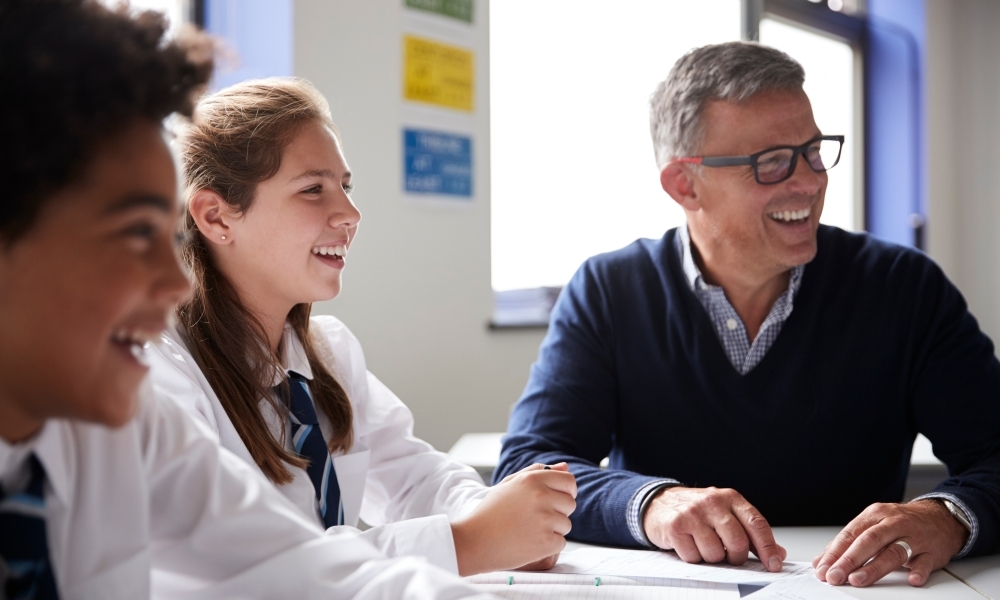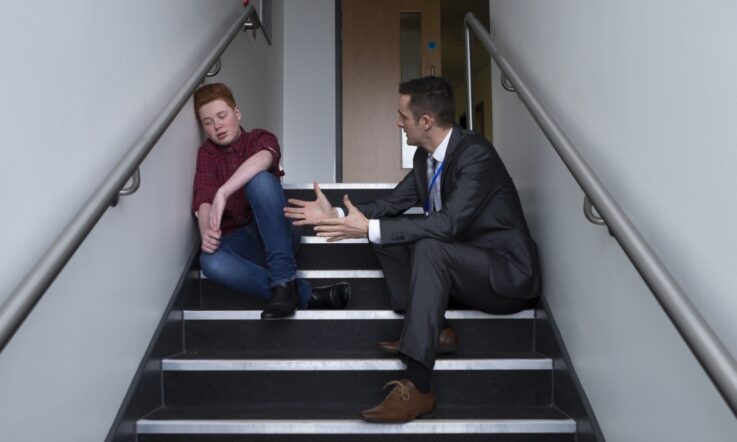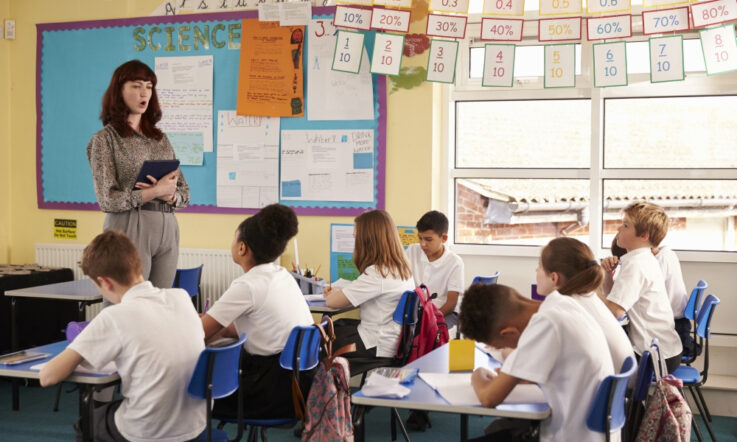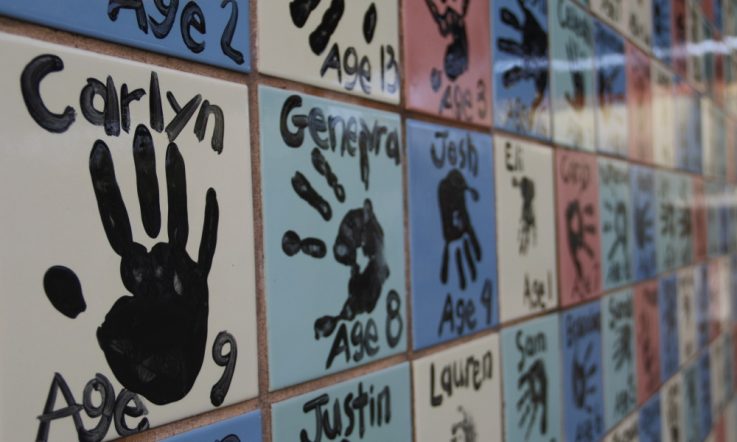This podcast from Teacher is supported by The Australian Volunteers Program. Are you interested in supporting communities overseas? Become a remote volunteer. Visit australianvolunteers.com to learn more.
Thanks for listening to this Behaviour Management episode from Teacher magazine, I’m Rebecca Vukovic.
Today is RUOK? Day, a national day of action here in Australia, dedicated to reminding everyone to check in on their loved ones and ask ‘Are you OK?’ For students, learning how to care for their own wellbeing and to support their peers to talk about how they feel is an important life lesson. In today’s episode, I’m joined by Professor Fiona Brooks, a medical sociologist and a professor of child and family health at the University of Technology Sydney. The focus of today’s discussion is the relationship between mental health, wellbeing and student behaviour at school. But, we also explore the state of child and youth mental health in Australia, why it’s important to approach poor student behaviour with empathy and compassion, and why meaningful student-teacher relationships can make a significant difference in any child’s life. Let’s get started.
Rebecca Vukovic: Professor Fiona Brooks, welcome to Teacher magazine. Professor Brooks, you’re a medical sociologist and a professor of child and family health at the University of Technology Sydney. You’ve published widely on topics relating to young people's health and wellbeing. Could you tell me a little more about your professional background and why this area of research is of particular interest to you?
Fiona Brooks: Yes thank you. The second decade of life is a really important developmental period where future life chances can really be set in stone. So it’s a really important time to consider how we can put the right kind of resources around young people to really ensure that they can thrive. And one of the things that’s really interested me around this is that young people are also tending to be seeing … while everybody wants to be young and youthful, young people actually themselves can be seen in a much more ambivalent light both in terms of policy context and in public perception.
So while a lot of energy and resources goes into the under fives, as it should do, that second decade of life can be a little bit undervalued and ignored and young people themselves can be seen quite negatively. Yet we now know from a lot of the cognitive research that’s been done, as well as all the outcome work around public health, we can really see that actually that second decade of life really does warrant some significant attention, if our population is going to thrive in the future.
RV: It’s clear that this is an issue you’re passionate about, which is why you’ve dedicated your career to researching this topic.
FB: Yes absolutely. I think it’s just fundamentally important and it’s an area where we can make a significant difference. A small input can really make a change in a young person’s life and affect their whole life course. For example, I’m sure every single person listening can identify and relate to a moment in their life, particularly in adolescence in secondary school, where a teacher or an adult made a difference by just showing an interest in you. I can certainly point to a teacher when I was in secondary school who actually encouraged and facilitated me. I was first in family and I would never have gone to university without that person’s support and input.
RV: That meaningful student-teacher relationship you’re describing there is something I’d like to return to later on in the episode. But for now, I’d like to start by exploring the relationship between mental health, wellbeing and a young person’s behaviour. On a really simple level, does their mental health and sense of wellbeing impact on their behaviour?
FB: Yeah, let’s take this back a little bit and think about 10, 15 years ago – the main concerns around young people’s health and wellbeing. Young people were considered pretty much, the second decade of life was considered to be a healthy period of time and the only things we were really concerned about was young people’s choices they made to participate in health risk behaviours. And that’s the usual suspects we all know about – the drugs, sex, rock and roll phenomena.
But over the last decade we have seen a decline in young people’s participation in all of those kinds of behaviours but actually at the same time, there’s been a significant, increasing concern about young people’s mental health. And that’s not just high levels of what would be considered clinical mental health problems but actually levels of anxiety, stress, all of that seems to be contributing to young people struggling during the second decade of life.
RV: Let’s dive a little deeper into that now – that is, the state of child and youth mental health in Australia. What are some of the key issues students are facing when it comes to their mental health?
FB: So we’re looking at around one in five, 20 per cent, of young people from age 11 to 17 experiencing high or very high levels of distress and those figures have been consistent for around the last decade, perhaps increasing slightly. It is a gendered issue so we do need to think about that. Girls and young women are much more likely to experience and report poorer mental health than their male peers. And for example the work I’ve undertaken in Europe – because this is a common pattern we see across pretty much all OECD countries, that’s Europe, North America, Australia, New Zealand – we see that kind of level, of high levels kind of poor mental health. And for example in the work that I’ve done, 35 per cent of all 15-year-olds that we surveyed, and this was in the UK, of all 15-year-old girls reported they had self-harmed at least once in the last year. Now that may only have been once but that shows you the level of distress that young people are likely to be experiencing.
So you asked Rebecca, what might be the determinants of that. I think it’s a complex set of factors that have kind of created a bit of a perfect storm for young people. [And] people often point to social media, and I think that has a role to play, both positively and negatively, and we have to understand that social media and new information technologies can actually be quite positive for young people. And some of the research I’ve done has shown that for example, gaming, computer gaming, can actually be quite positive, encourage pro-social behaviour and a whole set of other positive behaviours. But when taken to extreme, when you are sitting in your bedroom with your phone under your pillow all night, waiting for that text, when you’re likely to experience cyberbullying or some of the negative associations with new technologies, then that can be a contributing factor.
And certainly, we see cyberbullying, as we see mental health issues, increase with age. So, unlike normal bullying that kind of often is higher among the younger age groups and tends to be reported as decreasing as young people get older, cyberbullying seems to have a different pattern. And what young people have told us in the research we’ve done, that that kind of experience can be very distressing: a) because it’s often anonymised, you don’t know who is perpetuating it; you’re experiencing it very much on your own; you can never get away from it so whereas in the past you might be bullied at school but you can come home, you can get away with it, you could join other groups, when you’re experiencing cyberbullying, you can never get away, it’s always there, it’s always on your device.
Also, even if you’re not experiencing some of those very negative behaviours, the level of surveillance young people are under has increased exponentially. So you’re much more likely to feel judged, you’re much more likely to want to feel that you should look in a certain way and have that presented on social media formats, you know Instagram, and all of those kind of additional platforms, do have a role to play I think in generating some of these levels of anxiety.
The other side of it, it’s not just social media, the expectations on young people have increased exponentially. The expectations of performance at school has increased. It’s now much harder, you have to get higher grades to get into the courses you might want to do at university. The expectations around the work environment are much higher and young people feel that they’re going to be facing a much less certain future in terms of their future work or employment and financial security. So all of that is likely to be a contributing factor, a major set of determinants that create that, as I’ve said, perfect storm around young people to possibly increase levels of anxiety.
RV: And of course, this always leaks back into the classroom as well and I’d like to talk now about poor student behaviour in the classroom. I’m wondering Fiona, what are some key signs or giveaways that a student is struggling with their mental health or wellbeing? What kinds of behaviours should teachers be looking out for in their classrooms?
FB: Yeah I think for most teachers, the kinds of behaviours they would see that would be indicators of high levels of distress would be disengagement, perhaps in a student who has engaged well before the age of 11. What we see in these patterns is at age 11, boys and girls tend to have quite high wellbeing and it does decline with age. So that change around age 13 could be something that teachers could look out for.
I think what we also need to think about is, we often see these behaviours as very highly individualised within one student, but what we should perhaps be doing is turning this question around on its head and asking – What actually creates good behaviour in young people? Because now the research is pretty conclusive about a whole set of factors that can really help and the role that school and teachers can play in helping with that.
So there’s quite a considerable body of research that suggests school commitment, including young people’s attachment to teachers, shapes their affiliation with supporting peers. So a young person that will feel committed to school and engage with their teachers are also likely then to be picking and developing peer relationships with other peers who are of like-mind and supporting, engaged at school. So there’s a virtuous circle that we can start to trigger here if we start facilitating school connectedness and school belonging.
And this then will, ultimately, research has shown affect their behavioural choices. It affects their behavioural choices in the classroom, so we see more positive, affirming behaviours in the classroom and less participation in risk behaviours and health risk behaviours.
RV: For teachers too, it may be more effective for them to approach student behaviour with empathy and compassion, rather than other emotions, like frustration or anger for example. But when poor behaviour is displayed in the classroom, particularly when it breaches the disciplinary codes of the school, what is the most appropriate way for a teacher to address it?
FB: We know that schools that have very high punitive disciplinary practices actually are more likely to be associated with lower wellbeing for young people. Those as you said, exactly right, those who have a more empathetic approach to young people actually have higher levels of reported wellbeing amongst their pupils and we absolutely know that high levels of reported wellbeing are strongly associated with higher levels of attainment. So this is core business for schools. Actually getting wellbeing right in the classroom [is] really important for schools and for the outcomes they want to see in their communities and about their school. So this is really important for schools to help facilitate this.
There are a number of things that we know are associated with this. Teacher connectedness – so good, positive relationships with teachers. If young people feel that teachers are, an adult in their life is interested in them, cares about them, wants them to do well, then they are more likely to respond to that positively; and it is more likely to reinforce that virtuous circle I talked about, than get young people into a negative cycle.
We’ll be back after this quick message from our sponsor.
You’re listening to a podcast from Teacher magazine, supported by The Australian Volunteers Program. Did you know the Australian Volunteers Program is looking for teachers to support communities overseas? You can become a remote volunteer and help support positive change in developing countries. There are lots of education assignments now online. Visit australianvolunteers.com to find the right volunteer program for you.
RV: As you said just then, the research shows that having a significant, meaningful relationship with at least one adult in their life has been considered one of the most powerful assets to a young person’s health. What does that actually look like in the classroom though? Do you have any advice for teachers on how they can strengthen their relationships with students?
FB: You’re absolutely right, and we found, even where young people don’t have parental support (and it’s really important that parental support and teacher support works together, that’s the strongest set of relationships for young people), but we did find that where there wasn’t parental support, teacher support could act as a compensatory mechanism and still ensure that young people thrived. So the role of teachers here is critical.
But teachers need support to be able to do this. We found, for example, where there are good teacher-staff-student ratios (so some of this is systemic, we’ve got to get the right kind of support around teachers to enable them to provide this), so where there’s good student-staff ratios, then we see higher levels of teacher connectedness because actually teachers then have the capacity to give more attention to this.
Certainly there are … training and support for teachers is really important. There are lots of programs out there that provide social and emotional developmental programs for young people, but also ones that jointly provide support for teachers I think are also critical and they are becoming more common.
But the sorts of things that actually make a significant difference for young people is the teacher feeling they know you as a person. So if the teacher knows your name, that’s a fundamentally positive thing. If they just talk to you, ask you about how you’re doing and you sense that there’s an interest in you – that makes a significant difference to young people. These can be quite small things but they can make a significant difference to that young person’s experience of school, how they feel they belong in the school, and ultimately their attainment in school.
RV: Fiona, today is RUOK? Day, a national day of action dedicated to reminding everyone to check in on their loved ones and ask ‘Are you OK?’ So while I have you here I have to ask, why are days like today important? And, what do they teach young people in particular about supporting those around them?
FB: That’s really important. RUOK? – the reason I really like the message around RUOK? and I think it’s a really positive one for young people, is that it’s founded in a conversation can change a life. And a conversation with a young person during those critical years of 11 to 17, really can fundamentally change their lives. A teacher taking the time to have a conversation with a child or a young person that they feel might be struggling, I mean teachers should trust their instincts on this and actually just try and talk to the young person. That conversation could actually change somebody’s life and it can change their life in terms of their complete life outcomes. It can really turn things around for a young person.
What also participating in RUOK? can really help with as well for young people, is it can give them the set of tools they have to provide support to each other and if young people can learn how they can support each other through this – because quite often we find that young people may be reluctant to go to an adult in their life but will do so if a peer suggests that they do. So hearing from a friend who says, ‘hey are you okay?’ and talks to them about doing something about it could actually be the main trigger that again changes their lives.
RV: It’s such an important message. Professor Fiona Brooks, it has been a pleasure speaking with you today and hearing your thoughts on such an important issue. Thanks for sharing your work with Teacher magazine.
FB: You’re very welcome.
That’s all for this episode. If this episode has raised any issues for you, there is always support available. If you or anyone you know needs help, call Lifeline on 13 11 14 or the Kids Helpline on 1800 551 800. For support and resources visit beyondblue.org.au If you want to keep listening, there are more than 200 podcasts in our archive. You can find them on the Teacher website, or wherever you get your podcasts from. Don’t forget to hit that subscribe button on your podcast app, and please rate and review us while you’re there.
You’ve been listening to a podcast from Teacher, supported by The Australian Volunteers Program. Are you interested in supporting communities overseas? Become a remote volunteer. Visit australianvolunteers.com to learn more.
Think about the students in your class. How do you work to build positive relationships with all students? Have you considered how students perceive these relationships from their perspectives?
How do you go about approaching students who display disruptive behaviours? Do you lead with empathy and compassion? What impact does this have on their ability to regulate their own behaviour?



